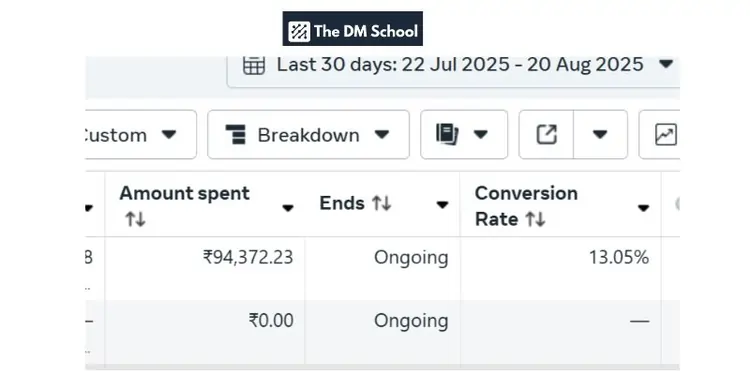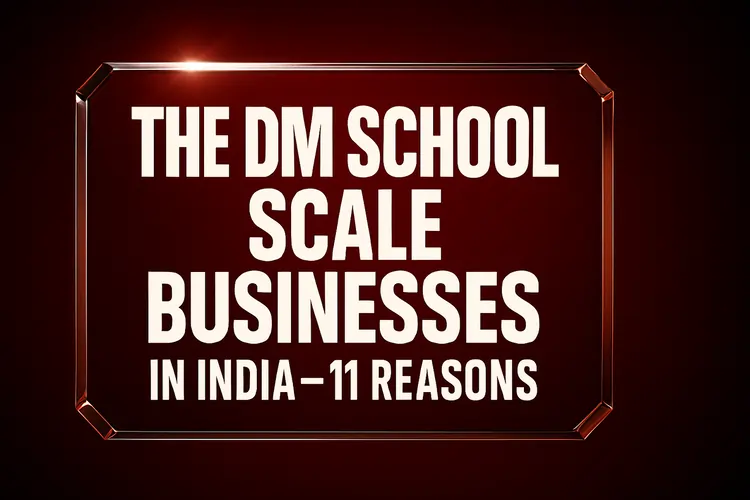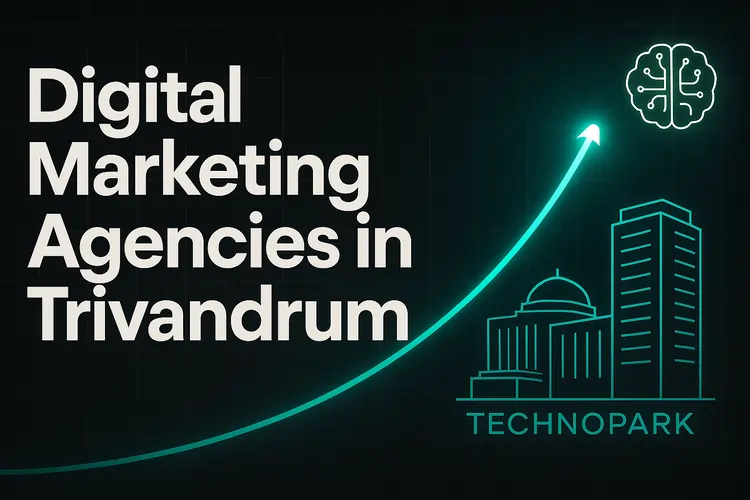Choosing between landing page vs website in India is not a design debate. It’s a profit decision. Send paid traffic to the wrong destination and you bleed budget. Get it right and your acquisition cost drops fast.
At The DM School, a recent Facebook Ads campaign converted at 13.05% conversion rate on a focused landing page (₹94,372 spend, last 30 days). That single decision—LP over homepage—moved ROI. This guide shows when a landing page wins, when a full website is smarter, and how to scale from one page to a revenue engine.
You’ll see India-first examples, costs, timelines, SEO trade-offs, and a 90-day plan you can execute this quarter.
Summary: The right destination multiplies ROI for Indian traffic.
Now you can judge LP vs website with confidence.
Contents — Landing Page vs Website in India
- What is a Landing Page vs a Website? (Quick Answer + India examples)
- Why Choosing Right Matters in India (ROI, ad spend, WhatsApp CTA)
- Core Elements Compared (trust signals, UPI/COD, mobile-first)
- Advanced Factors: Ads vs SEO Trade-offs & Scaling
- Tools, Costs & Timelines in India (build stack & budget)
- 90-Day Action Plan (from single LP to website strategy)
What is a Landing Page vs a Website? (India Examples)
Quick Answer: A landing page is a single, focused page built for one campaign or offer, while a website is a multi-page hub for brand, SEO, and services. In India, landing pages often win paid ad conversions, while websites support long-term growth.
A landing page is built with one goal — capture leads, sell a product, or push a specific action. It usually removes navigation links to keep visitors focused. Example: an EdTech founder in Bengaluru sending Google Ads traffic to a page offering a free webinar signup.
A website is broader. It has multiple pages — home, about, services, blog — and is designed for brand presence, SEO, and long-term credibility. Example: a Delhi-based coaching business showing all its programs, testimonials, and blog content to build organic trust.
Homepage vs Landing Page (Clear Contrast)
A homepage welcomes all visitors and gives them multiple paths to explore. A landing page is like a sharp arrow — it points to one target. For Indian D2C brands running festive campaigns, sending users to a landing page with one product + UPI checkout often outperforms a full website homepage.
| Feature | Landing Page | Website |
|---|---|---|
| Purpose | One campaign / offer | Full brand presence |
| Navigation | Minimal, CTA-only | Multiple links & sections |
| Best For | Google Ads, Meta Ads, WhatsApp CTAs | SEO, content, credibility |
| Example in India | EdTech webinar signup in Bengaluru | Coaching website in Delhi |
Summary: Landing pages are built for fast, campaign-driven conversions; websites are built for long-term presence.
Now you can separate tactical pages from brand hubs.
Why Choosing Right Matters in India
In India, the wrong destination can eat 40–60% of your ad spend. When you send Google or Facebook Ads traffic to a generic homepage, visitors get lost in menus. They drop off before acting. A focused landing page fixes this by removing clutter and driving one clear action.
For example, a coaching business in Delhi reduced cost per lead by 35% by switching from a homepage to a campaign-specific landing page. Globally, Neil Patel showed that ad-specific LPs outperformed generic pages by 115%. Mailchimp also reports that brands with 30+ landing pages generate up to 7× more leads than those with fewer than 10.
Indian audiences also behave differently. A WhatsApp CTA button can outperform a web form because it feels faster and more personal. In sectors like real estate or coaching, a simple “Chat on WhatsApp” converts better than asking for email IDs. This local nuance makes the choice of landing page vs website critical.
🔥 Pro Tip: In India, never send paid ad traffic to a homepage. Always create a landing page that mirrors your ad’s promise.
Summary: Matching ads with focused landing pages saves lakhs in wasted clicks.
Now you can protect ad budgets from being drained by generic pages.
Core Elements of Landing Pages vs Websites in India
A landing page lives and dies by focus. It should remove distractions and highlight one clear action. In India, the most effective pages include WhatsApp CTA buttons, UPI icons, GST details, and testimonials in local languages. These build instant trust with visitors who are cautious about online transactions.
A website carries the weight of brand presence. It needs navigation, service pages, blogs, and an SEO backbone. For example, an e-commerce store in Mumbai depends on category pages and organic search rankings, not just one campaign landing page. Both play roles, but their DNA is different.
Benchmarks prove the point: Shopify reports e-commerce landing pages convert at 4.2% on average, while entertainment event pages hit 12.6%. Add to that India’s mobile-first reality — StatCounter shows 73% of traffic comes from smartphones in 2025. If your landing page isn’t optimized for 4G/5G, you’re losing conversions daily.
⚠️ Mistake Alert: Using your website homepage as a landing page will crush conversion rates. Visitors need one promise, one button, not five menu options.
Summary: Landing pages drive fast actions; websites build long-term trust and SEO visibility.
Now you can separate tactical execution from brand presence in your funnel.
Advanced Factors — Ads vs SEO Trade-offs
A landing page is unbeatable for paid ads in India. It mirrors ad copy, matches intent, and drives a single action. That’s why The DM School hit a 13.05% conversion rate from Facebook Ads — the message matched perfectly. Global benchmarks also confirm the edge: Unbounce reports a 6.6% median CVR, while OptinMonster shows top performers at 11.45%+.
But here’s the trade-off: landing pages rarely rank in organic search. For long-term visibility, a website with structured blogs and service pages is essential. A coaching site in Delhi, for example, might rely on SEO traffic for 70% of its leads — something no single LP can deliver.
Scaling also matters. For paid campaigns, the best practice is “one landing page per ad group.” Indian accounts following this have reported CVR lifts of 20–30%. Unlike generic competitors who only compare features, we show when LPs scale ROI and when websites win on reach.
2. SEO Depth
Websites win for blog-driven keywords, rankings, and trust-building over months.
3. Scaling Strategy
1 LP per ad group maximizes performance; add website later for long-tail SEO.
Summary: Landing pages dominate ads, websites dominate SEO. Smart founders in India use both in sequence.
Now you can align campaigns with the right destination every time.
Tools, Frameworks & Costs in India
Building a landing page vs website in India isn’t just a strategic choice — it’s a budget and timeline call. A well-optimized landing page can be launched in 2–7 days for as little as ₹5,000–₹25,000. A 5-page website, on the other hand, may cost ₹20,000–₹1,00,000+ and take 2–4 weeks to complete.
The tool stack matters too. For landing pages, Indian founders often rely on Unbounce, Instapage, or WordPress with Elementor. E-commerce stores use Shopify and Wix. Adding WhatsApp Business API integrations is now a must — in many cases, a WhatsApp CTA outperforms forms by 20–30%. For websites, Webflow, WordPress, and Hostinger hosting are popular choices.
Proprietary benchmarks reinforce the case: At The DM School, managing over ₹10 Cr ad spend, focused landing pages consistently reduced cost per lead versus websites. When the goal is paid traffic ROI, LPs win. When the goal is brand authority and SEO, websites take over. Smart founders budget for both.
🛠️ Recommended Tools in India
- Unbounce / Instapage — high-converting landing pages
- WordPress + Elementor — budget-friendly flexibility
- Shopify / Wix — e-commerce stores
- WhatsApp Business API — instant lead response
- GA4 + Hotjar — track performance and behavior
Summary: Landing pages are cheaper and faster; websites cost more but build authority.
Now you can budget wisely based on campaign goals.
90-Day Action Plan (Landing Page + Website Strategy)
Here’s how Indian founders can structure the next 3 months to get maximum ROI from landing page vs website in India. The idea is to start lean, capture conversions fast, and then build long-term brand presence through a website.
📅 90-Day Breakdown
- Day 0–30: Build 1 landing page per ad group. Focus on message match, WhatsApp CTA, and mobile-first load speed.
- Day 31–60: Scale to multiple LPs across campaigns. Add GA4 + Hotjar tracking. Run A/B tests on CTAs and headlines.
- Day 61–90: Expand into a website. Publish service pages, blogs, and testimonials. Start SEO optimization to reduce long-term ad dependence.
At The DM School, campaigns structured like this influenced over ₹100 Cr in client revenue. The flywheel is simple: capture fast wins with LPs, reinvest in content-rich websites, and build a dual engine of Ads + SEO.
Summary: Landing pages deliver quick wins; websites build compounding growth over quarters.
Now you can follow a 90-day roadmap instead of guessing where to start.
Conclusion — Landing Page vs Website in India
The biggest mistake Indian founders make is sending paid ad traffic to a homepage. That single misstep burns lakhs in wasted clicks. A landing page, when crafted right, turns the same traffic into predictable revenue. A website, on the other hand, builds credibility, SEO presence, and long-term trust. Both are weapons — but they must be used at the right time.
Six months from now, you’ll look back and see that choosing the right destination wasn’t just a design decision — it was the turning point for your ROI. Landing pages give you speed; websites give you scale. Smart Indian businesses don’t pick one forever. They use both in sequence.
🚀 Ready to build landing pages that actually convert? Book a free consultation with The DM School and start scaling today.
Summary: Landing pages win for paid ads, websites win for long-term SEO. Use both, not one.
Now you can align your marketing with the right growth engine in India.
FAQs — Landing Page vs Website in India
Is a landing page the same as a website?
No. A landing page is a single campaign-focused page, while a website is a multi-page hub for brand, SEO, and content.
Do I need a landing page or a website for Google Ads in India?
For ads, a landing page works best because it matches ad intent and improves conversion rates. Websites are better for SEO.
Can a landing page rank on Google in India?
Rarely. Landing pages are built for ads, not SEO. To rank organically in India, you need a website with content depth and backlinks.
What is the difference between a homepage and a landing page?
A homepage introduces the full business with multiple paths. A landing page drives one focused action, like a signup or WhatsApp click.
How many landing pages should a business in India have?
Ideally one per ad group or campaign. More landing pages mean better message match and higher conversion potential.
What is the cost difference between a landing page and website in India?
A landing page may cost ₹5K–₹25K and launch in days. A 5-page website can cost ₹20K–₹1L+ and take weeks.
Which is better for long-term growth in India — landing page or website?
Use landing pages for fast ad conversions. For long-term growth, websites win with SEO, trust, and organic leads.


